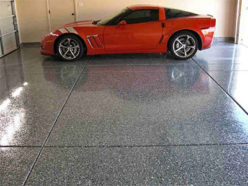Although today it’s extremely rare that you get bubbles in the epoxy such as these in the images below. But it can happen so we need to talk about why it can happen and what you need to do to fix it. The bubbles will usually show up the next morning when you’re ready to apply the next coating.


Although this condition rarely happens these days, it used to happen more frequently cause in the old days lots of floors were not installed with vapor barriers. All fairly new floors have vapor barriers. Some floors installed prior to 1980 may not have had a vapor barrier installed. If you have a 30 or 40 year old floor it’s a good idea to do a moisture test BEFORE you order an epoxy floor kit. A simple way to do that is to tape down a 3×3 or 4×4 square foot piece of plastic and seal it all around with some good duct tape like Gorilla Tape. Let it sit for 24-48hrs and then remove the plastic to see if any moisture has accumulated underneath. If no moisture is present you’re good to go, if there is moisture take a picture and send it to us. We have products that can deal with moisture but moisture issues need extra consideration. Please note that moisture that gets on the floor from above is of no concern, we are only concerned with moisture coming up from below the slab.
The next reason you can get bubbles is by mixing the epoxy with a drill at full speed. This will whip air into the epoxy which will then have to escape during the curing process causing bubbles and other deformations to occur in the epoxy. This is easy to avoid and really never happens, just using medium speed on the drill will prevent this problem. Take a look at Coolest Gadgets to find reviews for good cordless drills that are able to operate at various speeds for whatever projects necessary.
The next reason is applying the epoxy in direct hot sunlight. This can happen but again it’s easily avoided(who wants to work in direct sun on a 100 degree day!). On a very hot day lets say above 95 with direct sun hitting the floor, the epoxy will start to cure extra fast making it difficult to work with in a short period of time. Remember our epoxy is military grade pure epoxy, it’s not your typical water based or store bought epoxy. Our epoxy cures via catalytic reaction and is not an air cure. This means that while curing it generates heat and the more heat the faster it cures. So you don’t want to be adding extra heat like direct sun on a 100 degree day. Direct sun on cooler days is fine. So just a little precaution will prevent too rapid a cure that will trap in air. Bubbles can form from a few hours to a few months after application. The good news is they are easily avoided by a simple moisture test if a moisture issue is suspected, don’t mix the epoxy with the drill at super high speed and close the door if you have to apply the epoxy with direct sunlight baking the floor on a very hot days above 95.
What do you do in the event of bubbles in the epoxy? Very simple as long as it’s not due to moisture vapor coming up through the slab. Hopefully you read this article and did a moisture test first. Which means most likely you mixed the epoxy at full speed or you were rolling super fast and you whipped some air into the coating. No big deal! Don’t panic. Simply cut off the bubbles, lightly sand with 100-150 grit paper and reapply a little more epoxy. Make sure you apply the topcoat to all other areas right away and then topcoat the bubbled area when the new epoxy cures. Problem solved and more importantly problem avoided!
 This is a common question that has a few different answers. It depends on what type of vehicle you will be parking on your new epoxy floor and what type of epoxy paint you used. You normally have to wait a few days before parking any vehicle on a newly coated floor. The reason being is that although the epoxy will be dry to the touch in about 8-10 hours the chemical curing process is still going on.
This is a common question that has a few different answers. It depends on what type of vehicle you will be parking on your new epoxy floor and what type of epoxy paint you used. You normally have to wait a few days before parking any vehicle on a newly coated floor. The reason being is that although the epoxy will be dry to the touch in about 8-10 hours the chemical curing process is still going on.



